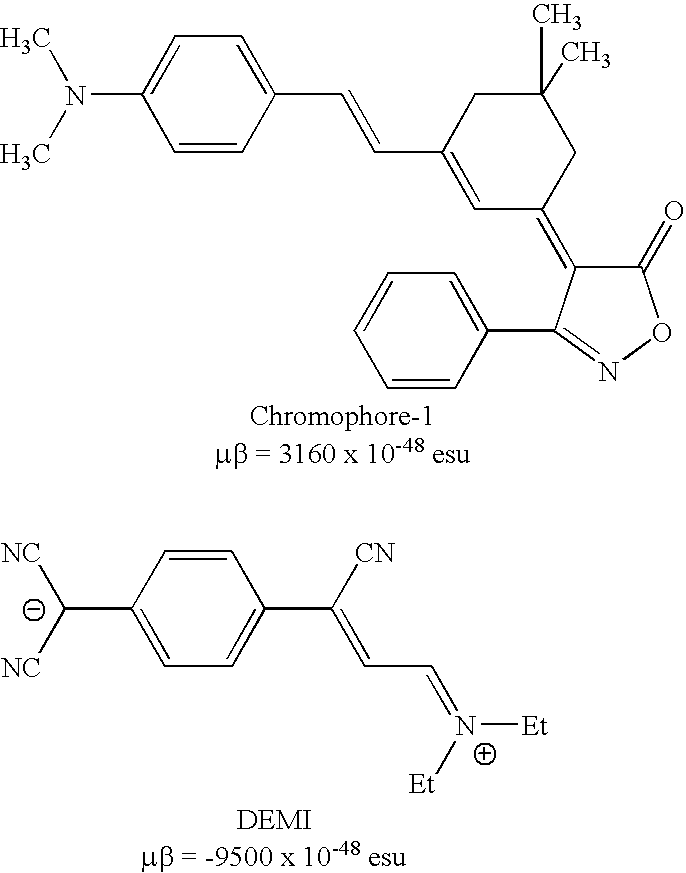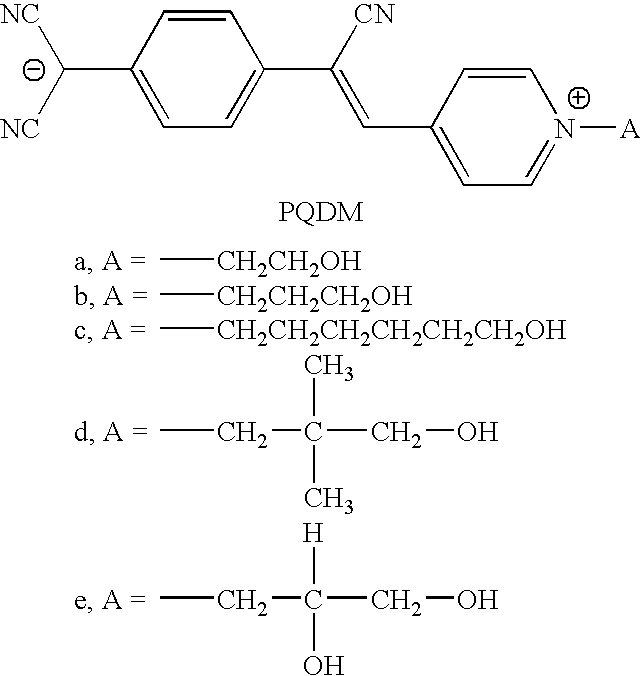Zwitterionic chromophores and macromolecules containing such chromophores
- Summary
- Abstract
- Description
- Claims
- Application Information
AI Technical Summary
Benefits of technology
Problems solved by technology
Method used
Image
Examples
example 1
N-(2-hydroxyethyl)-4-picolinium bromide (Ia) and its Derivative Ie
[0046] In a 3-neck, round-bottomed flask flushed with nitrogen, 2-bromo-1-ethanol (40.01 mmol), 4-picoline (43.57 mmol) and absolute ethanol (16 mL) were combined and heated for 3.5 hours at 50° C. under nitrogen with stirring. The reaction was stopped and the contents of the flask were transferred to a one-neck round-bottomed flask. The solvent was removed under vacuum and the residue was washed with diethyl ether (4×100 mL) and any remaining solvent was removed under vacuum. The product was obtained as a viscous orange liquid in 34% yield. 1H NMR (200 MHz, CDCl3) 8.9 (2H, protons on pyridine ring), 8.0 (2H, protons on pyridine ring), 2.6 (3H, CH3), 4.6 (2H, —CH2O), 3.8 (2H, —NCH2—), 5.2 (1H, —OH); IR (neat, cm−1) 3303 (OH), 1640 (aromatic C═N), 1474 (aromatic C═C).
[0047] The esterification reaction of Ia with the corresponding acid chloride or anhydride (which is derived from 4,4-bis(4-hydroxyphenyl)valeric acid) ...
example 2
N-Hexyl-4-picolinium bromide (Ib)
[0048] A solution of 4.65 g of 4-picoline (50 mmol), 9.90 g of 1-bromohexane (60 mmol) and 30 mL of acetonitrile was refluxed for three hours and then cooled to room temperature. The viscous mixture was then added dropwise into 100 mL of ether with vigorous stirring. The mixture was let to stand for a while and then the upper ether layer was decanted. The residual viscous solution was dissolved in 10 mL of acetonitrile again and dispersed into 100 mL of ether. This procedure was repeated two more times in order to completely remove the unreacted starting materials. The resulting viscous liquid was dried under vacuum to give 11.8 g of off-white wax (92% yield). 1H NMR (DMSO-d6, 400 MHz): 0.89 (t, 3H), 1.26 (m, 4H), 1.85 (m, 4H), 2.64 (s, 3H), 4.81 (t, 2H), 8.0 (m, 2H), 8.9 (m, 2H); IR (CHCl3, cm−1): 1398 (C═C), 1635 (C═N), 2975 (N—C).
example 3
N-Benzyl-4-methylpyridinium chloride (Ic)
[0049] A solution of 2.53 g of benzyl chloride (20 mmol), 1.86 g of 4-picoline (20 mmol) and 20 mL of acetonitrile was refluxed for three hours, cooled to room temperature and then frozen in refrigerator. Pale pink crystals precipitated from the solution, which were collected by filtration and washed with ether (3×5 mL) to afford 4.09 g of the product (92% yield). 1HNMR (DMSO-d6, 400 MHz): δ 9.1 (s, 2H), 8.0 (d, 2H, J=6.24), 7.5 (s, 2H), 7.4 (m, 3H), 5.8 (s, 2H), 2.6 (s, 3h); 13C NMR (DMSO-d6, 100 MHz): δ 159.0, 143.5, 134.3, 128.9, 128.8, 128.3, 61.9, 21.1.
PUM
| Property | Measurement | Unit |
|---|---|---|
| Percent by mass | aaaaa | aaaaa |
| Percent by mass | aaaaa | aaaaa |
| Temperature | aaaaa | aaaaa |
Abstract
Description
Claims
Application Information
 Login to View More
Login to View More - R&D
- Intellectual Property
- Life Sciences
- Materials
- Tech Scout
- Unparalleled Data Quality
- Higher Quality Content
- 60% Fewer Hallucinations
Browse by: Latest US Patents, China's latest patents, Technical Efficacy Thesaurus, Application Domain, Technology Topic, Popular Technical Reports.
© 2025 PatSnap. All rights reserved.Legal|Privacy policy|Modern Slavery Act Transparency Statement|Sitemap|About US| Contact US: help@patsnap.com



